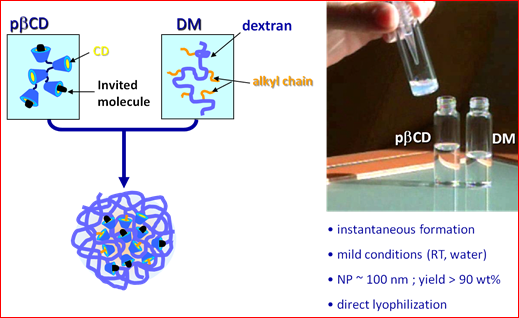Accueil > Équipes scientifiques > Nanomédecine et Biophotonique (NanoBio) > Nanoparticules de type "cage" pour lutter contre des maladies sévères
Nanoparticules de type "cage" pour lutter contre des maladies sévères
Nanoparticules de type "cage" pour lutter contre des maladies sévères
Research topics
The main goal of the team is to develop engineered nanoparticles to treat severe diseases such as cancer and infections using scalable “green” solvent-free technologies. Of main interest are “cage” nanoparticles, in which the drugs are confined in cavities inside the nanoparticles, thus maximizing the interactions with the matrices and allowing reaching high loadings and controlled release profiles. One example are highly porous hybrid metal-organic (MOF) nanoparticles produced by hydrothermal synthesis and able to load drugs by simple impregnation in aqueous solutions.
Nature Materials, 9, 172-178, 2010, J Mat Chem B, 34, 2013

Recently, the surface of the nanoMOFs has been modified with ligands for targeting purposes by a simple one-step “green” technology in water, without any solvent or coupling agents, enabling a stable coating in biological media.
Scientific Reports 2015
Cyclodextrin (CD)-based nanoparticles and polymers are another example of “cage” systems able to load molecules of interest by impregnation in aqueous solutions.
J Control Release 2006,
Nanomedecine 2014
Drug-loaded nanoparticles spontaneously self-assemble upon mixing two aqueous solution of associating neutral polymers.

Equipment and ongoing projects
Equipment is available to produce nanoparticles by various techniques (nanoprecipitation, emulsification, crosslinking, microwave-assisted synthesis etc) and fully characterize them (size distribution, porosity, composition, surface charge, stability, concentration measurements, etc). Various anticancer and antibiotics can be encapsulated and the release profiles can be studied and correlated to nanoparticle degradation and stability. Furthermore, the team interacts with the biology and microscopy departments for in vitro cell interaction studies.
The responsible of the team is Dr. Ruxandra GREF, 1st class research director at CNRS. She has an interdisciplinary background in nanotechnology, polymer science and chemical engineering. Dr. Gref has been principal investigator in the “CycloN” Marie Curie Initial Training Networks - FP7-PEOPLE-ITN-2008 European project (http://itn-cyclon.eu/) aiming to develop a new generation of multifunctional drug nanocarriers based on cyclodextrins to fight cancer.
Dr. Gref coordinates since March 2014 the European network “CycloN Hit” gathering 17 participants among which 7 companies, with the goal to design novel nanocarriers for the delivery of antimicrobial agents to fight resistance mechanisms (http://itn-cyclonhit.eu/).
Since March 2015, Dr. Gref coordinates the ANR Project ANTI-TB-NANO (ANR-14-CE08-0017) aiming to develop “Green” nanoparticles for tuberculosis treatment.
The team is involved in the LABEX Nanosaclay (http://nanosaclay.fr/) and has long term collaborations with Institut Lavoisier (team of Dr. C. Serre), Institut Galien (Pr. P. Couvreur) and IRAMIS (CEA, Dr. Th. Berthelot).


